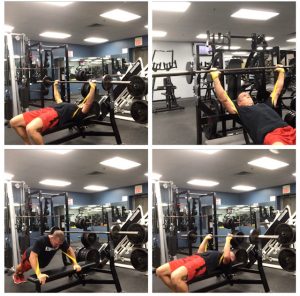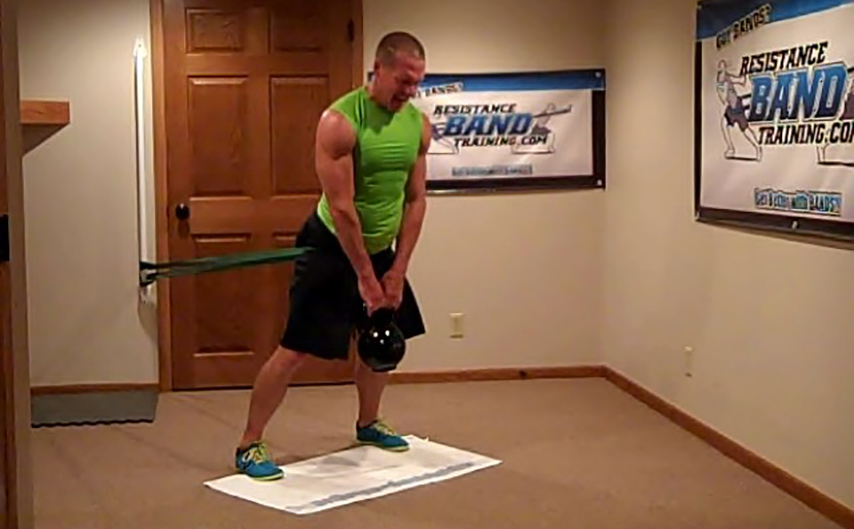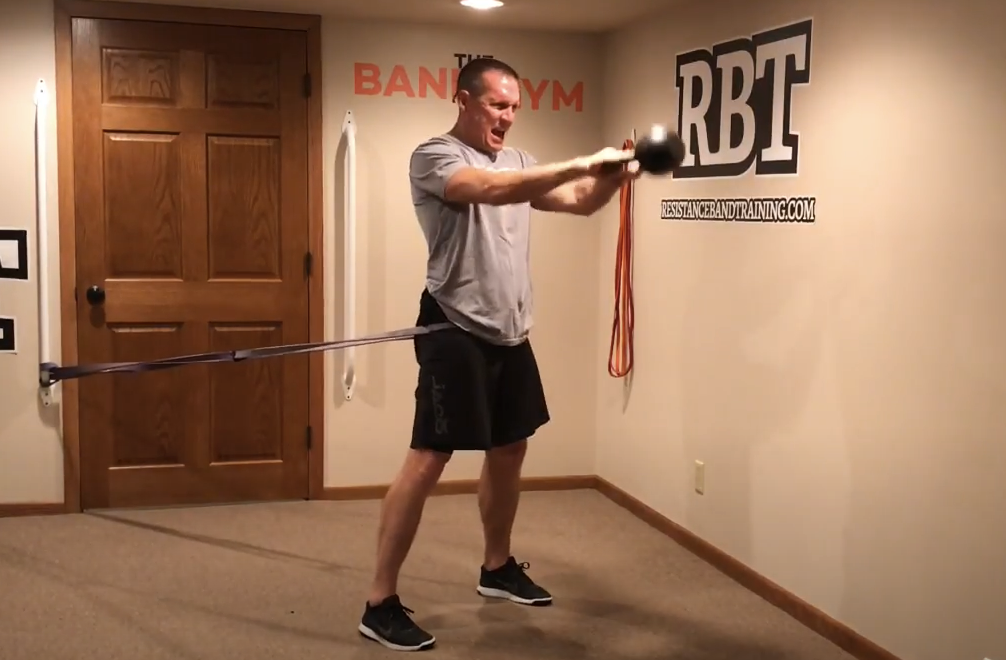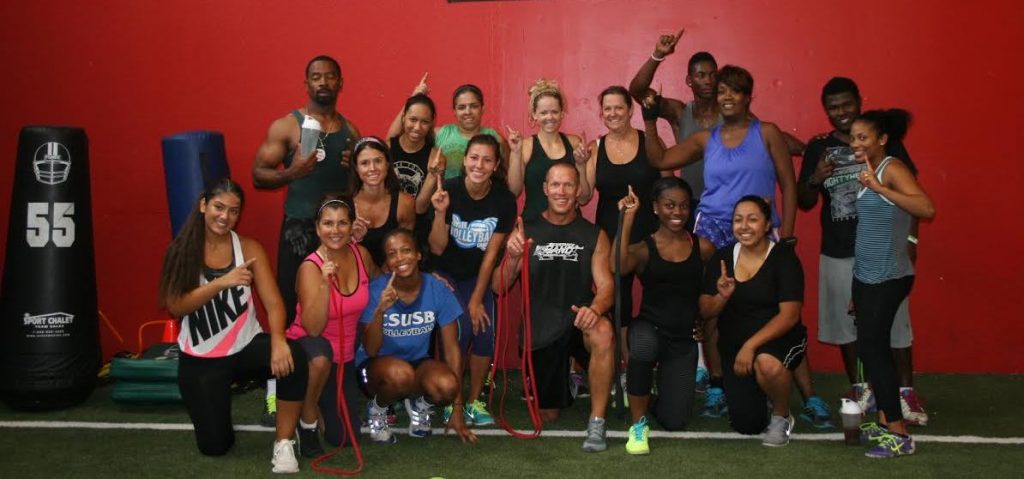Attaching bands to the body is the best way to get started with contrast training
Attaching bands to your body, versus to the weight training tool, is going to create greater benefits and less risk of injury when first getting started with contrast training. In traveling around to different training facilities, I obviously take note of how trainers and coaches are using bands.

Specifically, I clue into if they are attaching bands onto the tool (barbell, kettlebell, or dumbbell) or if they are attaching bands to the body. I am a huge fan of contrast training which involves combining band variable resistance with free weight constant resistant.
However, I am not a fan of attaching bands to a barbell, dumbbell or kettlebell in most cases. In my opinion, attaching bands to a barbell is an advanced contrast training approach that should only be used by very experienced or competitive lifters. For the average recreational weightlifter, attaching bands to the body is a safer and more efficient way to contrast train.
7 Reasons for Attaching Bands to Your Body
1. Places the resistance closer to the center of gravity
Most recreational or youth weightlifters don’t have the stability and muscle memory to optimally perform a bench press or squat movement with the bands attached to the bar. Without optimal trunk and hip stability, peripheral joints are going to be asked to stabilize at a very high level.
For the average recreational lifter, the shoulders, knees, elbows, wrists and ankles are not able to create this level of needed stability. As a result, these joints can become compromised by injury. Attaching the band to the body, places the resistance closer to the center of gravity. This, in turn, allows for better stabilization of the weight training tool.
2. Provides tactile external stimulus for muscle contraction
Most recreational lifters recruit stabilizers better when provided with some type of tactile external stimulus that helps them feel what muscles need to contract. Applying bands to the hips (vs the barbell) automatically engages the glutes. For example, the band belt setup works well to add band resistance to squatting or dead lifts, but it also creates superficial pressure that instantly engages the hips. As a result, individuals will be able to control the bar, dumbbell or kettlebell much better in their squat.
3. Keeps workouts simple
Attaching bands to the body keeps workouts simple. The goal for a recreational lifter using contrast training is to challenge the body by combining a variable resistance (the band) to a constant resistance (the free weight). As a result, attaching the band to the barbell, versus the body, does not alter this goal. Therefore, why risk losing control of the barbell or over stressing peripheral joints by attaching bands to the barbell, dumbbell or kettlebell when the goal of contrast training can be met using a safer body attached setup?
4. It’s more efficient
It’s more efficient to attach bands to the body than to the weighted device when training. Using body attached band setups allows the lifter to scale their band resistance to meet their strength level and in turn not have to constantly change out free weight resistance, which will also result in having to detach and reattach the bands.
5. Allows for a more time efficient workout
Attaching the band to the body allows for a more time efficient workout for recreational lifters, who often have a limited amount of workout time. As an example, using the following band push setup allows individuals to quickly go from incline bench press to a push up to a flat bench press without having to change anything.
6. Allows you to quickly shorten the band
Attaching the band to the body allows you to quickly shorten the band if needed. As a result, band contrast resistance can be quickly modified. It is far more challenging to shorten or change the band resistance attached to the weighted training tool. It is also much easier to swap out the band when using a body attached setup vs. a barbell attached setup.
7. Allows you to train different planes of movement
Attaching bands to the body provides recreational lifters with the ability to train different planes of movement. For example, by applying a dynamic stabilizer to dumbbell squatting a frontal plane stabilization force is created. In turn, applying simultaneous horizontal vectors by applying the hip attachment creates a sagittal plane force. In both cases you can create uniquely different lifting responses that keep the muscles guessing.
Disadvantages of Attaching Bands to the Body
1. It’s difficult to quantify resistance
One disadvantage is it is difficult to accurately quantify the resistance created by the band. I can understand the importance of that for the elite lifter but it’s a non-issue for youth or the recreational lifter. Keep in mind that contrast training is a way to change up weight lifting to create muscle strength and adaptations occurring.
2. Could create superficial skin irritations
Attaching bands to the body could create a superficial skin irritation which can be quickly eliminated. Making sure there is a clothing barrier between the band and the skin will eliminate most, if not all, skin irritation issues. Also with flat bands, correctly placing the band onto the body without twists will minimize any skin irritation. Allowing the band to become loose during training or be twisted could irritate superficial tissues.
Key Contrast Training Tips
1. Maintain tension on the band setup
To maximize contrast training results, it is important to maintain tension on the band setup throughout the full range of motion. Allowing the band to become loose at the initiation of the concentric phase of the movement will create the potential for band migration. This can create avoidable joint shearing.
2. Don’t overload with band resistance
When first incorporating contrast training, don’t overload with band resistance. Learn how to control the movement and accelerate the concentric phase before increasing band resistance. Keep in mind that one of the goals in contrast training is to learn how to accelerate a weight, not just lift it.
Most People Think The Band Gym is “ONLY” about Training with Bands
Learn How to Contrast Train with Bands and Free Weights
Click Here to Get Started




